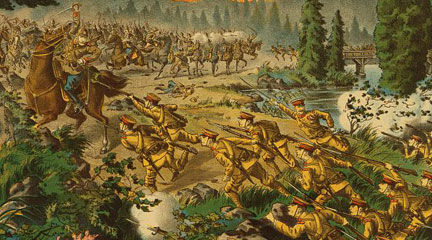Teaser
Explore the rise of animosity between the U.S. and Japan through primary source documents and related classroom activities.
Description
Explore the rise of animosity between the U.S. and Japan through primary source documents and related classroom activities.
Article Body
Four separate lessons make up this unit on “The Road to Pearl Harbor.” Like most lesson plans from EDSITEment—a project of the National Endowment for the Humanities—this unit is full of rich primary source material and a wide variety of related classroom activities. The unit is guided by four questions, designed to help students understand the long run-up to military conflict between the U.S. and Japan. Reflecting those questions, the unit is divided into four lessons: exploring the growth of U.S./Japanese hostility during World War I and after, looking at American foreign policy during the Sino-Japanese Conflict in the 1930s, examining the Japanese “Southern Advance” of 1940 and 1941, and finally, highlighting the failures of diplomacy that ultimately led to war. The unit does an excellent job of representing historical contingency—revealing how the bombing of Pearl Harbor was actually the product of decades of history. Further, it will help students understand the multiple causes of Japanese aggression—from Japanese imperial ambition to U.S. foreign policies. Each lesson comes with a brief but complete historical background essay embedded with hyperlinks to primary sources, clear and concise suggestions for student activities, worksheets, and ideas for formal and informal assessment. And the interactive timeline tool is an excellent resource that pairs nicely with other aspects of the lessons. There are some things to watch out for, though. Many of the primary sources are long and will need to be carefully selected or vigorously edited, depending on your students’ reading level and persistence. The assessments are only roughly outlined, meaning that teachers will need to fill in the details and establish their own grading criteria. Additionally, while lessons range in length from 1–2 class periods to 3–4 class periods, they collectively require fairly extensive class time—roughly two weeks; consequently, they will most likely need to be used selectively. However, this unit is still an excellent resource. By picking and choosing from among the activities, carefully selecting documents, and further developing one or two assessments, teachers can adapt the lesson to their particular needs.
Topic
The Road to Pearl Harbor: The United States and East Asia, 1915-1941
Rubric_Content_Accurate_Scholarship
Rubric_Content_Historical_Background
Yes
Significant historical background is provided for each of the four individual lessons that constitute the larger lesson plan.
Rubric_Content_Read_Write
Yes
Students read primary documents and there are multiple opportunities for writing.
Rubric_Analytical_Construct_Interpretations
Rubric_Analytical_Close_Reading_Sourcing
Yes
Students are asked to read source information carefully enough to be able to put it to use in assignments.
Rubric_Scaffolding_Appropriate
Rubric_Scaffolding_Supports_Historical_Thinking
Rubric_Structure_Assessment
Rubric_Structure_Realistic
Rubric_Structure_Learning_Goals
Yes
Directions are brief and clear. Teachers must design necessary supports.

